The hut-to-hut hike on the Alta Via 1 (AV1) is one of eight roughly parallel Alta Via routes through the Dolomites in Northern Italy. This UNESCO World Heritage Site in the the Tyrolean Alps is known for its rugged beauty. The AV1 is generally regarded as being the easiest of the routes, but don’t mistake that for being easy with 3,000-foot elevation gains and losses in a day being common. A couple of days involve airy climbs and though it’s easy to avoid via ferrata climbing routes (see below), some short sections have cables through mildly exposed sections for safety. Planning a hut-to-hut hike on the Alta Via 1 in the Dolomites, Italy is daunting, but this article will help you through it.
Many international visitors fly into Venice and take ground transportation (bus or train) to Cortina, a convenient and scenic base camp, before starting the hike.

Between Rifugio Averau and Rifugio Citta di Fiume
The Alta Via 1 is approximately 70 miles (112 km) long. Most people start at Lago (Lake) di Braies near the town of Dobbiaco and head south to the end near the town of Belluno. The trailhead starts at Lago di Braies. Overall, the elevation is not particularly high compared to other classic trails, reaching a maximum of 9,029 feet (2752 m). Altitude sickness is not a concern for any but the most sensitive individuals. The elevation gain, however, is significant at 21,833 feet (6665 m). The Cicerone guidebook divides the AV1 into 11 stages. We did the trek in 9 days but there are many variations in how the route can be divided.
The Dolomites were named after geologist Deodar Dolomieu, who identified the calcium-magnesium carbonate composition of the predominant rock.
During World War I, the boundary between Italy and the Austral-Hungarian empire ran through the Dolomites, leaving behind a fascinating collection of tunnels, foxholes and artifacts along the trail. Due to shifting borders at different times, German, Italian and Ladin (an ancient language) are spoken in the region. English is spoken by many, but not all, people in hotels, restaurants, shops and rifugios.
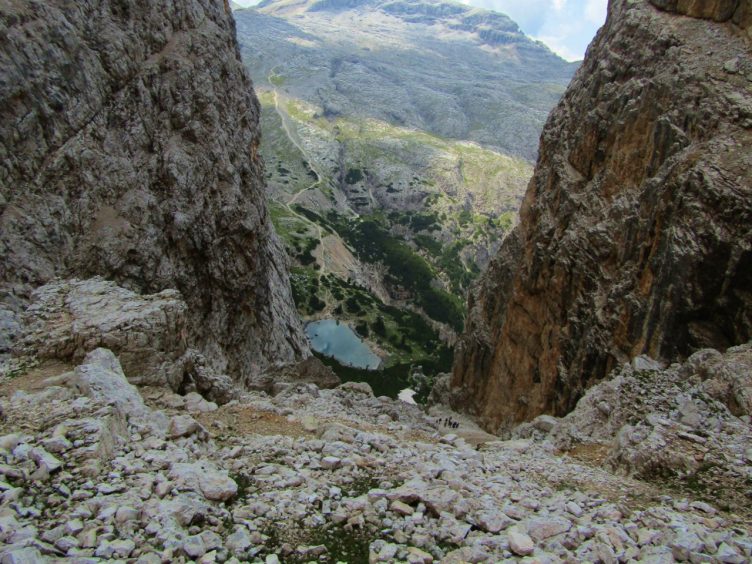
The Forcela di Lech is an airy descent described as a “plunging, stomach-dropping gully”
Summer is hiking season and, like many alpine environments, how early or how late you can go depends on seasonal variations in snowfall. Mid-July to mid-September are ideal. Snow is likely to linger into early July. Snowstorms can occur anytime in the summer, usually with little accumulation. We had 3-5 inches of snow one August night that persisted for a couple of days.
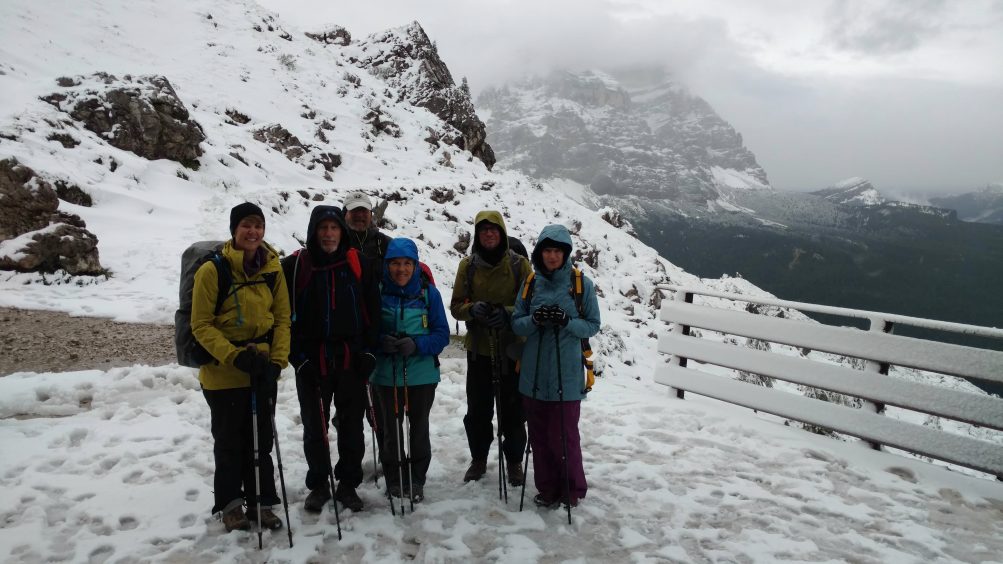
An unexpected snowfall in August at Rifugio Coldai.
Make reservations as early as possible. We made our reservations in January and still didn’t get everything we wanted. Friends who decided to join us later could not get reservations at all for the first few days so they joined us the afternoon of Day 3 and did a five-day hike.
Depending on your budget and style, you can make reservations on your own or use a service. We chose Macs Adventures to suggest a route, make reservations and provide us with custom trail information. They provided us with the Cicerone guidebook so there is no need to purchase one if you decide to use a service. We had a U.S. based contact who was very responsive and being relatively local, time zone differences were minimized. Our only issue was that there were a few glitches with reservations, with each of three couples having a missing reservation at one time or another. It’s unsettling to pay the fee to the service, hike all day and arrive at a rifugio in pouring rain to find that they have no record of a reservation. In each case, the hosts made room, sometimes using creative methods, to accommodate us. Since Macs Adventures is well-known, no payment was expected and they worked it out. Macs was apologetic and refunded our night’s stay.
If you decide to make your own reservations, the rifugios are listed in the Cicerone guidebook.
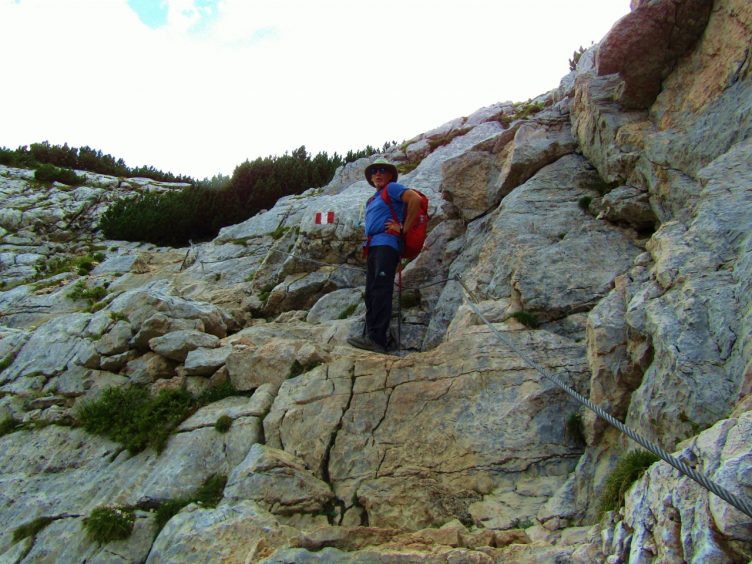
An easy cabled section that didn’t require via ferrata gear.
Via ferrata (‘iron road’ in Italian) routes may involve significant exposure so if you suffer from a fear of heights, lack hiking experience or don’t have the proper gear, you’ll probably want to avoid these. Via ferrata gear includes a helmet, climbing harness, short length of rope (lanyard) and a carabiner that can be attached to fixed protection (e.g. cables bolted into the rock). Via ferrata routes may be noted on a map. The Tabacco maps we purchased used a cross/plus sign (+++++) to mark aided sections. If you have booked through a tour company, they likely provided route cards that either avoid via ferrata routes or make it very clear where they are and how to avoid them if desired.
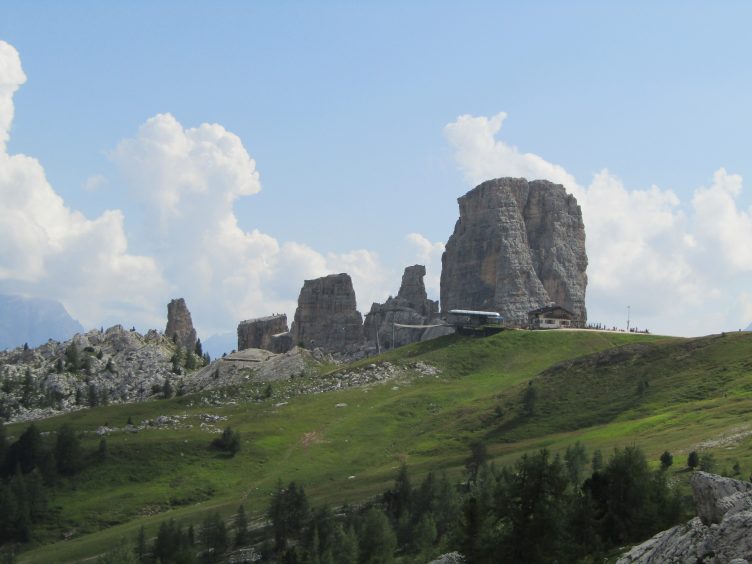
We approached the Cinque Torri rock formation, visible from Cortina, on Day 4.
This represents our itinerary. We walked the length of the AV1 but variations are possible. We engaged Mac’s Adventures to make our rifugio reservations, which included half-board (breakfast and dinner) and custom route cards). Distances are approximate. Time includes breaks and lunch.
Our favorite rifugios were Lavarella and Averau. Lagazui was insanely busy and the staff seemed frazzled. Coldai had the most unique perch. Our friends did not find a welcoming environment at the extremely rustic Rif. Nuvolau and it cannot be recommended. The people at Pian de Fontana were exceedingly nice and welcoming. Some of the four-hour days were a bit short for our style but days 3 and day 8 were very tough and should not be underestimated. We missed day 7 due to snow that caused us to backtrack to a road where we called a taxi.
See below for link to spreadsheet with these and other rifugios.
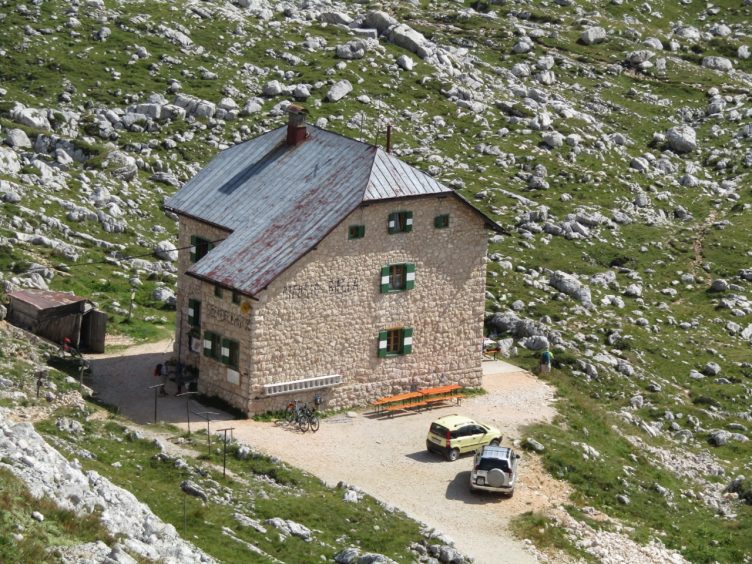
The rifugio is always a welcome sight at the end of the day (Biella).
I covered the basics for a hut-to-hut hike in Packing for a hut-to-hut Tour of Mont Blanc so I’ll just cover some differences for this trip. I didn’t find my pack on the TMB to be comfortable though the 35-liter size was adequate. I have an array of high-end backpacking packs that have more capacity than I needed for this type of hike. I decided to bring my Z-Pack Arc Zip 55-liter pack that carries light loads very comfortably and just didn’t use all the space. I limited my packing to the 42-Liter main compartment with the collar opening rolled all the way down. This worked very well for me and the pack was comfortable throughout the trip.
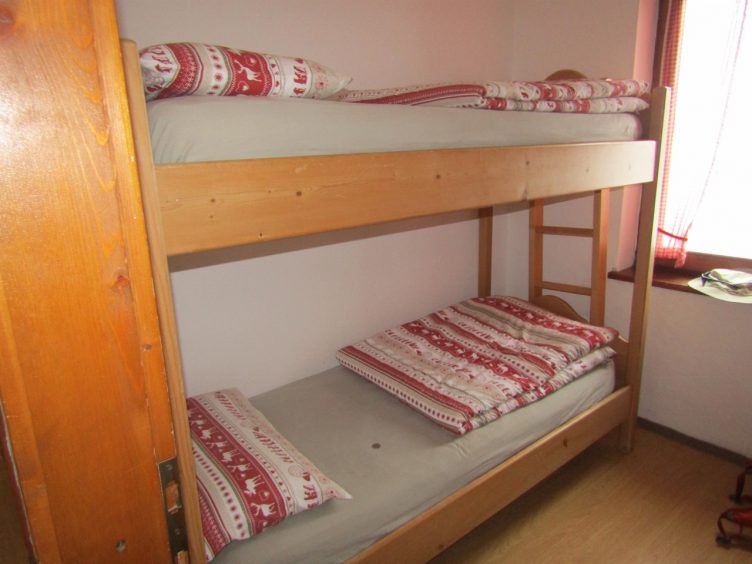
Typical bunks (Coldai).
We enjoyed and appreciated all the rifugios (refuges, huts) that we stayed in but there was tremendous variation among them. We booked fairly early (January) but still had trouble reserving private rooms. We didn’t care that much and were satisfied with two private rooms reserved out of 10 nights. There must have been cancellations because we ended up getting more private rooms than that.
The older, more rustic rifugios are like a slice of history. Some are Alpine club huts. These older huts tended to be small, with cramped dorm spaces. Rows of double bunks sometimes only had enough space between them for one person to walk and there might only be one or two token-operated showers for varying minutes that served many people in succession. A cramped dorm room might mean that access to upper bunks was only possible with an upright ladder versus an easier angled ladder. The menu choices and breakfast spread tended to be limited though filling food was always available.
Some huts were pure luxury. These cost a lot more per night and had many amenities such as boot driers and even a sauna in one. These had multiple showers and the dorms were more spacious. Extensive wine and beer options and multiple menu options at meal times were a treat.
Backpacking (wild camping) is not permitted in this area. We saw one group of tents on our second day, which looked like a large, organized group, but that’s it. Everyone else stayed in rifugios.
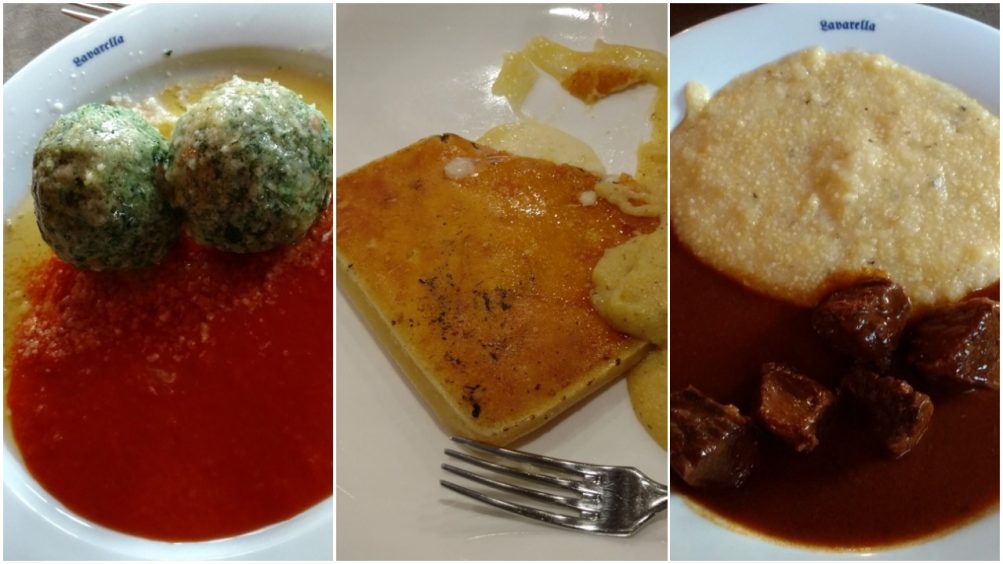
Spinach dumplings, fried cheese and beef goulash are regional specialties.
We chose half-board so we received breakfast and dinner at the rifugios.
Breakfast in the rifugios were all served buffet style. Eggs (soft boiled) were rare while muesli, yogurt, bread and pastries were common, along with coffee, tea and juice. Sometimes sliced cheese and ham were available.
Lunch was not included and had to be ordered from the rifugios the night before. We found the offerings to be good quality but a little monotonous. Each day it was the same: a large roll with thin slices of speck (a cured meat similar to prosciutto but smoked) and cheese. Nothing else; no condiments, nothing. Toward the end I requested a whole tomato (firm Roma tomatoes hold up remarkably well in a sack lunch), which added a welcome touch to our sandwiches. Usually an apple was included but occasionally it was an orange. The third component was a sweet treat, often Loacker wafers.
Dinner was the most variable among the rifugios. Most had a fixed menu with at least two or three choices but occasionally there was only one option. Rarely, a full menu was offered. The quality was consistently good with hearty portions. Many times, there was too much food after a large (and much appreciated) green salad or soup, pasta course, main course (often with polenta or potatoes) and dessert. Wine and beer was always available for purchase.
Some examples of dinners we enjoyed were pork chops (Biella), schnitzel or goulash (Lavarella), osso bucco (Lagazui), fried eggs/speck/potatoes (Averau), charcuterie plate (Citta di Fiume), venison goulash (San Sebastiano) with creamy polenta, fried cheese and pasta with eggplant (Pian de Fontana), strangolapreti (spinach dumplings), canederli (bread dumplings with bits of speck and chives), casunziei (ravioli with beet filling). Goulash is more like beef stew with paprika, better than what you think of in the U.S. version. Fried cheese was common in the region using local cheeses such as schiz or tosela that soften with high heat but don’t melt as most American cheeses would. It is typically served by itself, just a large square of cheese fried in butter with crispy edges. I grew to appreciate fried cheese quite a bit.
The food is generally meat-heavy and while some offer vegetarian main courses, many do not. Our vegetarian/pescatarian friends learned from their previous trips to the Alps and brought some protein-heavy foods to supplement the plentiful grains and vegetables. Foil packets of tuna and salmon made a good addition to pasta.
Snacks were mostly brought from home. Since the AV1 doesn’t go through any towns, we started the trip with all the snacks we’d need for the entire trip. Ten days of snacks adds up! Like the TMB, the kinds of energy bars and other snacks that I use to stay fueled up during the day were not widely available in Italy. See Food Choices on the Tour of Mont Blanc. We brought trail mix, jelly beans, energy bars and jerky. Check customs requirements before deciding what you bring. I have found that in most cases when traveling to other countries, it is safest to bring foods in their original packaging and leave the homemade foods behind. Bring some extra zip-top baggies to repackage food upon arrival and for foods you may pick up along the way. We stocked up on cheese, salami and chocolate in Cortina before we started the hike.
Drinks: Aperol Spritz became our drink of choice when we were celebrating the end of a long day. The bright red fizzy drink made with prosecco, Aperol apertif and a splash of soda was bright, refreshing and festive.
Potable water was not available at every rifugio. This surprised us and, had I known, I would have brought my SteriPen or chlorine tablets to purify water rather than contribute to a huge supply of plastic bottles. If potable water was not available, the rifugio included a bottle with dinner. Hikers need more than one bottle of water to rehydrate after a day’s hike and to restock for the next day’s hike so we had to purchase liter bottles of water each day in those locations, which tended to be in remote locations.
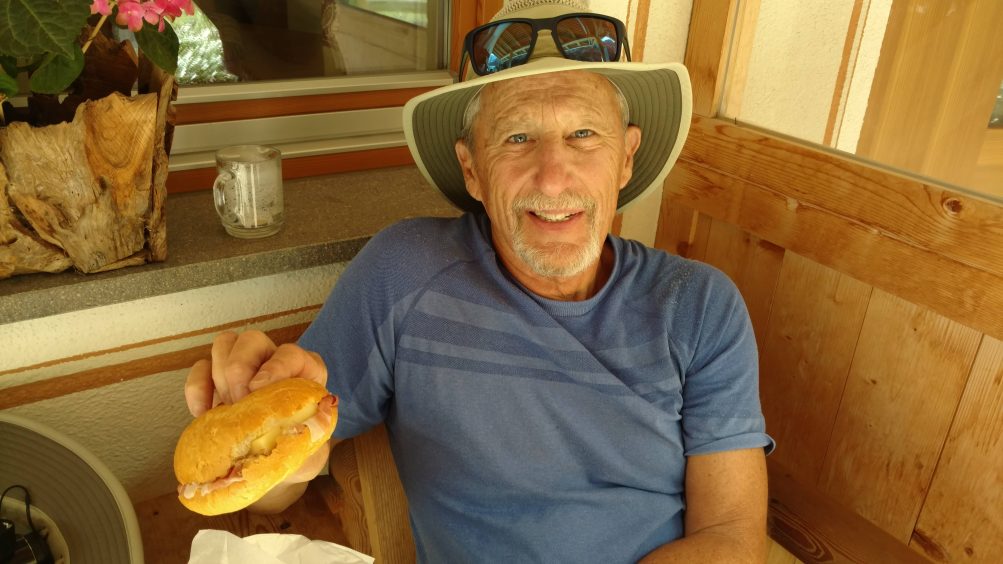
Speck and cheese sandwich. Every day.
The trail is well signed but be aware that signposts list time, not distance. A sign with “2h30m” means that it will take the average hiker two and half hours to the next milestone. We found that it was pretty accurate for our pace. The estimates are consistent so if you are faster or slower than the times indicated, you can expect that to carry through the whole trip.
The most common guidebook you’ll see is the Cicerone guide. The guidebook has small maps but it’s helpful to have a large topographic map to see the route and surrounding terrain. If you book through a service, you’ll likely receive route cards as well. See below for links to resources.
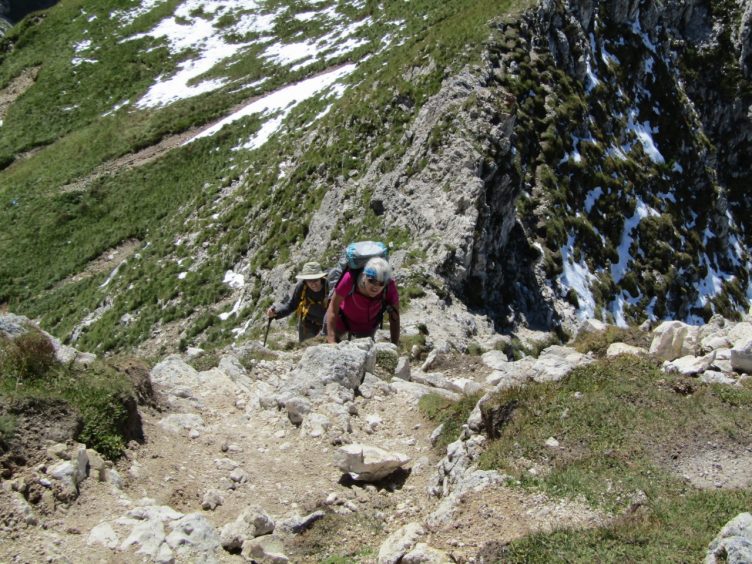
This was a tough day but Julie and Monique have no trouble scrambling up this steep, exposed ridge whose flanks plunge down to the valley below on the way to Pian de Fontana.
Since many international visitors hike either one or both of these classic trails, many are curious about the differences between the TMB and AV1. The trails are more similar than different but there were some nuances. Here are some that a group of us who have hiked both trails identified.
Tour Company (there are many that offer similar services at varying prices): Mac’s Adventures (they provided the Cicerone Guidebook and the Tabacco maps below).
Rifugio list: Rifuginrete.com.
Link to spreadsheet with notes on rifugios (if you have trouble with the link, contact me and I’ll email an Excel spreadsheet to you)
Guidebooks:
Maps: Tabacco Maps
Air Service to Venice: Google Flights (check route and prices)
Bus Service: Venice-to-Cortina and Cortina-to-Dobbiaco: Dolomiti.org
Luggage Transfer Service: DC Transfers (used and recommended by our friends to transfer luggage between Cortina and Belluno)
Photo Essay on Flickr:
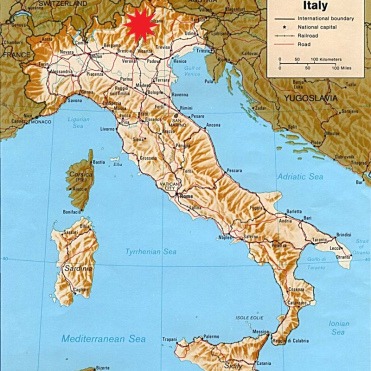
Location of the Dolomites in Italy.
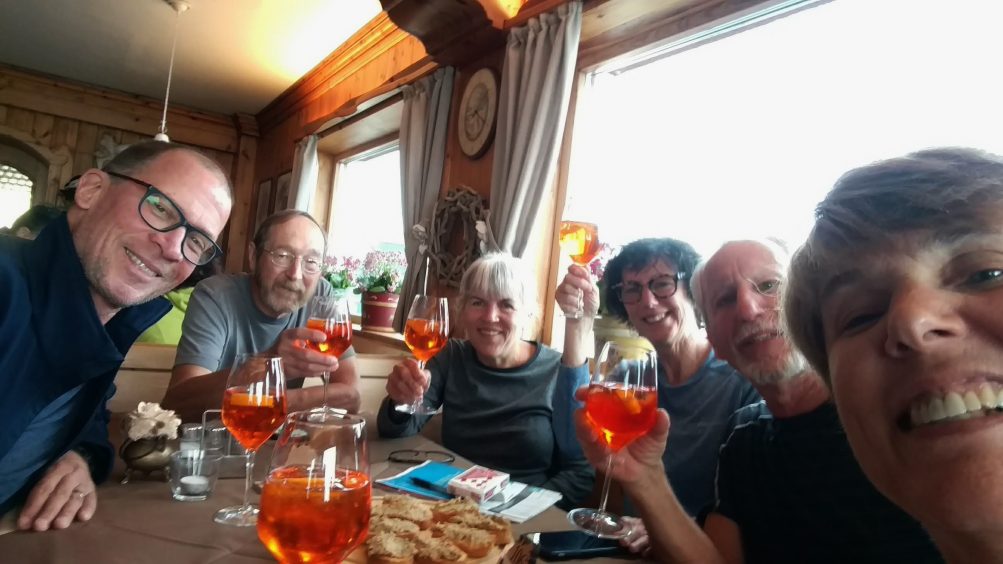
Glenn (L), Bruce, Julie, Monique, Steve and Inga enjoying an Aperol Spritz at Rif Lagazui.
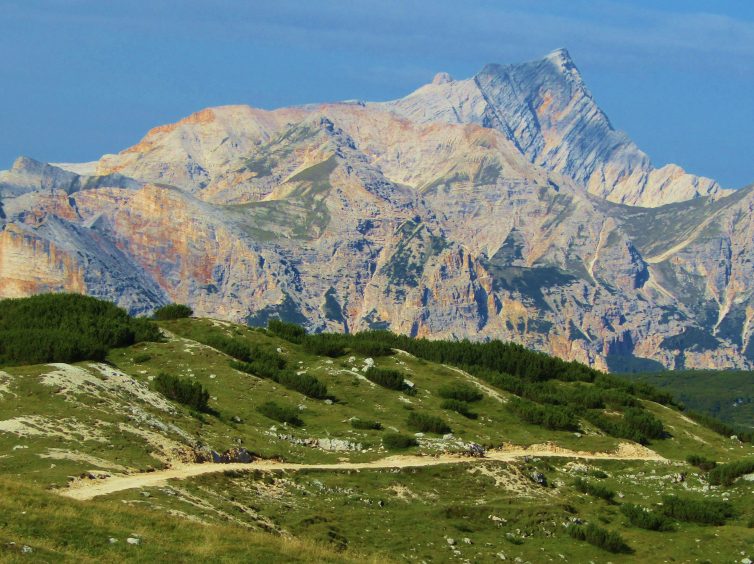
Parco Naturale delle Dolomiti d’ Ampezzo near Rif Biella
 Previous Post
Previous Post

Julie Felix says:
Well done!
Linda Jackson says:
thank you so much. that was interesting and beautiful <3 it does my heart good to see bruce and julie exploring the world. much love, linda <3
JO says:
Thanks so much for your spreadsheet on the refugios – just planning a trip now. Daunting!
Wayne Pettigrew says:
We are doing the AV1 in July in 7 days but are used to eight hour hiking days so that shouldn’t be a problem. The lack of potable water is good to know. What were the normal temperatures in the morning and afternoon?
Inga says:
Temperatures were pleasant during the day for the most part. However, there were a few days of rain and wind where it was quite cool though not below freezing.
Melissa Stansfield says:
Amazing! Thanks for all of this information! Very useful 🙂
Karyn Levy says:
Thanks for the lovely info.May I ask what you needed to carry ie sleeping bags etc?And also what was the cost of the hike and the refuggios?Thank you
Inga says:
Thank you for your comment, Karyn. I recommend checking the Mac’s Adventure to get current pricing. Prices are listed on the website and you can compare to other companies. See my packing article for the Tour of Mont Blanc as the equipment was the same: https://ingasadventures.com/packing-for-a-hut-to-hut-tour-of-mont-blanc/. No sleeping bag, just a sleeping bag liner for the rifugios.
Vanessa R Vardon says:
Thank you for this and your previous summary of what to bring on a hut to hut. We’re headed to the region for 9 days of day hiking on various trails (we made our itinerary ourself) and three overnight hut hikes so these two posts have been a god send! Looks like you guys had a great time – we’re so excited!
Kimberly Snow says:
This was just wonderful!!! I already planned my route and when I came across your page was comforted that you found it doable and choose almost all the same Refugio as I did. I also like the fact you included break times. I just wish you did day 7 as that is the only day I am concerned about. My group consists of experienced hikers but that makes for 3 hard days in a row. Anyway, thank you for your wonder through trail report.
Inga says:
Hi Kimberly, I’m glad you found it helpful. Yes, I wish we had been able to do Day 7 but it wasn’t possible with all that snow. It was billed as a tough day.
Cailin says:
Thank you very much for your blog! I’ve used all of your information and your spread sheet to plan our trip in September!! Looking forward to it!
-Cailin
Kristine Velschow says:
Hello,
We want to do either the AV1 og TMB this july. You say that the TMB is a bot more dramatic than the AV1. Can you describe that a bit more. Is it the scenery or the hike itself. To us it looks like the path is more difficult on the AV1. Which tour gives you the most spectacular views?
Would really appreciate you input on this.
Inga says:
Hi Kristine, I was referring to the scenery. On the TMB, you are circling the mountain while crossing through three different countries so the views are ever-changing. There are glaciers and snow-covered peaks. On the AV-1, there was no snow and the views had some variation but were more similar each day. The hiking was similar but each route had its individual challenges, including a couple of the days on the AV-1. They are both beautiful hikes and worth doing.
Inga
Tilghman says:
This is such a thorough itinerary, thanks for sharing!! Question regarding your route…did you cut the route short? I’m reading that the route is closer to 100 miles in length and on your spreadsheet it’s showing 63.7 cumulative miles. I appreciate any insight you can provide!
Inga says:
I’m not sure what happened. I borrowed the beginnings of the spreadsheet and modified it so maybe some miles were lost. There are also variants to the route so perhaps that accounts for some of the difference. Oh, we did have to skip one segment due to a sudden snowstorm and deep snow. We hired a car to drive us. I mentioned that we missed Day 7 in the article.
Anu says:
Hi,
I did TMB last year. Since we will be a group with different set of fitness levels, wanted to know if there are sections we could skip like in TMB and how we can make it shorter by skipping the boring parts.
If you have any write-up on it, please share.
Thank you
Inga Aksamit 2 says:
Thanks for writing. I didn’t find any of it boring! Skipping on the AV1 is harder than the TMB because the AV1 doesn’t go through any villages–services are more limited. There might be some buses and we were able to find a private driver through assistance from a refuge when we needed it. Beyond that, I don’t have any experience with ways to shorten it.
Inga
Nathalie Lafleur says:
Is there now (2024) transportation’s service for luggage through the trek(each night) ? And which one between TMB and AV1 would be easier for a 1st experience ? Which one would have more offers for public transportation and gondola for some sections ? nathalielafleur@videotron.ca
Inga Aksamit 2 says:
My article is up to date. There is no luggage transfer service between huts and the trail still doesn’t go through any towns. If you don’t have a lot of long distance hiking experience or want more amenities like luggage transfer and bus options, the Tour du Mont Blanc is a better option to start with.